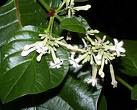As the prototype for the drug aspirin is found in the willow bark, so quinine, the antidote for malaria was discovered in the cinchona trees, of which there are around 38 species. The tree is native to the South American continent and was widely used by the Incas for chills and fevers, including malaria. The Spanish conquerors discovered the uses it is said when the Spanish Governor’s wife, the Countess of Cinchona got a heavy bout of malaria in 1638 and the Incas were prevailed upon to supply their antidote. The ground bark of the “quinquina” tree to be drunk in water was the first “Indian tonic water”, although this was later credited to British Indian Army officers in India in the 19th century. They began to take their quinine with their gin and soda water in 1825, at the cocktail hour and because of the tonic quality of the quinine, it was known as ‘gin and tonic’ still favoured by the Brits today. By then trees were cultivated in India.
 The botanical name of the tree became that of the Spanish countess, and Jesuit priests took the remedy to Europe where malaria was common. However, protestant Europe was sceptical of Jesuit offerings and it was not immediately accepted as a cure. This was also because the barks of all types of tree in the genus were not effective enough to bring about complete cures.
The botanical name of the tree became that of the Spanish countess, and Jesuit priests took the remedy to Europe where malaria was common. However, protestant Europe was sceptical of Jesuit offerings and it was not immediately accepted as a cure. This was also because the barks of all types of tree in the genus were not effective enough to bring about complete cures. The trees can grow up to 100 feet, and are evergreen, with red, pink or white flowers which are covered with silky hairs. They are now cultivated in South America and India and the Indonesian island of Java. They are members of the Rubiaceae family of plants which means that they are related to coffee and the Kadamb tree.
The trees were successfully cultivated in India and by 1867 they were doing well. It was from India that trees were sent to Java and now Indonesia produces most of the world’s quinine supplies.
 The bark is called Peruvian bark by some and has a long history of use in Europe as it was officially mentioned in the London Pharmacopoeia of 1677. Today the bark is used as a tonic, an antiseptic and in sun lotions. Quinine can now be produced chemically which is good news for the Cinchona which is now harvested in a sustainable way, with the bark from the tree and root branches taken from trees that are between 6-8 years old. By the end of the 19th century the bark from the tree was so much in demand in the West that the trees were severely depleted almost to the point of extinction in South America. This is also happening to the Himalayan yew and many other plant species. Unfortunately we do not seem to learn from our mistakes.
The bark is called Peruvian bark by some and has a long history of use in Europe as it was officially mentioned in the London Pharmacopoeia of 1677. Today the bark is used as a tonic, an antiseptic and in sun lotions. Quinine can now be produced chemically which is good news for the Cinchona which is now harvested in a sustainable way, with the bark from the tree and root branches taken from trees that are between 6-8 years old. By the end of the 19th century the bark from the tree was so much in demand in the West that the trees were severely depleted almost to the point of extinction in South America. This is also happening to the Himalayan yew and many other plant species. Unfortunately we do not seem to learn from our mistakes. There are other uses for the bark of this tree, one being to help stop irregular heartbeats (arrhythmia) and to prevent the legs cramping at night. It has antifungal and antibacterial properties, and can boost the appetite and help the digestive system function normally. It has been used in Ayurvedic medicine for stomach cramps and dysentery among other ailments. In Venezuela it was used in traditional medicine as an anti-cancer agent. It is also used as insecticide and to repel insects.
There are other uses for the bark of this tree, one being to help stop irregular heartbeats (arrhythmia) and to prevent the legs cramping at night. It has antifungal and antibacterial properties, and can boost the appetite and help the digestive system function normally. It has been used in Ayurvedic medicine for stomach cramps and dysentery among other ailments. In Venezuela it was used in traditional medicine as an anti-cancer agent. It is also used as insecticide and to repel insects. The native people of South America use the trees for many things including oral problems and an infusion of the bark is a good gargle for sore throats.
Luckily this species of tree has been saved from extinction, mainly because it was cultivated in places other than its natural habitat and so the depleted stocks in its original habitat were left in peace to replenish themselves.


































